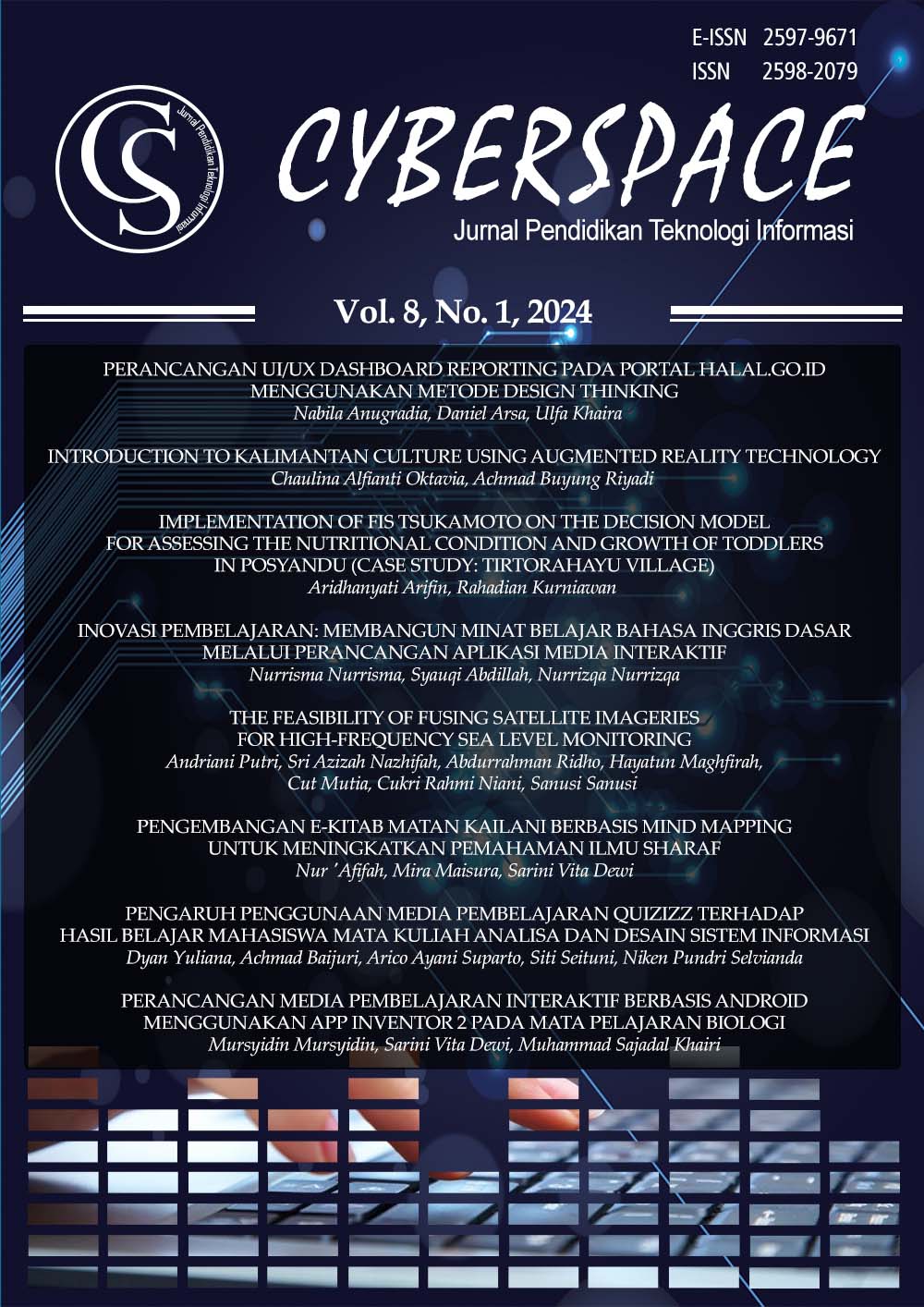PERANCANGAN UI/UX DASHBOARD REPORTING PADA PORTAL HALAL.GO.ID MENGGUNAKAN METODE DESIGN THINKING
DOI:
https://doi.org/10.22373/cj.v8i1.22948Keywords:
Design Thinking, Halal.go.id, Heuristic, Reporting, UI/UX,Abstract
The research aims to design a UI/UX dashboard reporting system for the Halal.go.id Portal using the design thinking method. This method involves research stages: Empathize, Define, Ideate, Prototype, and Test. The research employs qualitative methods with observation, interview, and heuristic evaluation techniques. The results indicate that the designed reporting dashboard achieved a score of 358 and a percentage of 89.50% based on 10 heuristic evaluation instruments, falling under the "Very Good" category. This signifies that the reporting dashboard is highly suitable for implementation to improve the UI/UX aspects of the Halal.go.id Portal. This research contributes to the design of effective and efficient UI/UX dashboard reporting for users of the Halal.go.id Portal. The research findings are expected to contribute to enhancing the quality of information services related to halal products in Indonesia.References
Slamet Rusydiana, A., & Marlina, L. Analisis Sentimen terkait Sertifikasi Halal. JEBA (Journal of Economics and Business Aseanomics), 5(1), 69–85, 2020.
BPJPH. Tentang BPJPH. Halal.Go.Id. https://bpjph.halal.go.id/detail/tentang-bpjph, 2022.
Razi, A. A., Mutiaz, I. R., & Setiawan, P. Penerapan Metode Design Thinking Pada Model Perancangan Ui/Ux Aplikasi Penanganan Laporan Kehilangan Dan Temuan Barang Tercecer. Desain Komunikasi Visual, Manajemen Desain Dan Periklanan (Demandia), 3(02), 219, 2022.
Angelina, K., Sutomo, E., & Nurcahyawati, V. Desain UI UX Aplikasi Penjualan dengan Menyelaraskan Kebutuhan Bisnis menggunakan Pendekatan Design Thinking. Tematik : Jurnal Teknologi Informasi Komunikasi (e-Journal), 9(x), 70–78, 2022.
Brown, tim. Design Thinking. Harvard Business Review, 86, 84–92,141, 2008.
Vanada, D. I. Practically Creative: The Role of Design Thinking as an Improved Paradigm for 21st Century Art Education. Techne Serien - Forskning i Slöjdpedagogik Och Slöjdvetenskap, 21(2), 21–33, 2014.
Pratama, M. A. D., Ramadhan, Y. R., & Hermanto, T. I. Rancangan UI/UX Design Aplikasi Pembelajaran Bahasa Jepang Pada Sekolah Menengah Atas Menggunakan Metode Design Thinking. JURIKOM (Jurnal Riset Komputer), 9(4), 980, 2022.
Angelina, K., Sutomo, E., & Nurcahyawati, V. Desain UI UX Aplikasi Penjualan dengan Menyelaraskan Kebutuhan Bisnis menggunakan Pendekatan Design Thinking. Tematik : Jurnal Teknologi Informasi Komunikasi (e-Journal), 9(x), 70–78, 2022.
Pratama, M. B., & Yusup, D. Analisis dan Perancangan Ulang User Interface Aplikasi MPP Kota Bogor Menggunakan Metode Design Thinking. 7, 18848–18862, 2023.
Fahrudin, R., & Ilyasa, R. Perancangan Aplikasi “Nugas” Menggunakan Metode Design Thinking dan Agile Development. Jurnal Ilmiah Teknologi Infomasi Terapan, 8(1), 35–44, 2021.
Diah Indrayani, I. G. A. A., Bayupati, I. P. A., & Putra, I. M. S. Analisis Usability Aplikasi iBadung Menggunakan Heuristic Evaluation Method. Jurnal Ilmiah Merpati (Menara Penelitian Akademika Teknologi Informasi), 8(2), 89, 2020.
Downloads
Published
Issue
Section
License
Authors who publish with Cyberspace Journal agree to the following terms:
- Authors retain copyright and grant the journal right of first publication with the work simultaneously licensed under a Creative Commons Attribution License that allows others to share the work with an acknowledgement of the work's authorship and initial publication in this journal.
- Authors are able to enter into separate, additional contractual arrangements for the non-exclusive distribution of the journal's published version of the work (e.g., post it to an institutional repository or publish it in a book), with an acknowledgement of its initial publication in this journal.
- Authors are permitted and encouraged to post their work online (e.g., in institutional repositories or on their website) prior to and during the submission process, as it can lead to productive exchanges, as well as earlier and greater citation of published work (See The Effect of Open Access).



















